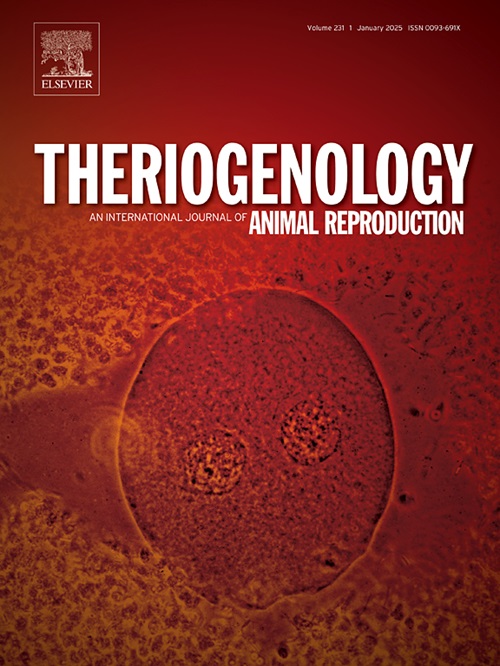跨膜蛋白95作为一种有前景的雄性精子功能分子标记
IF 2.4
2区 农林科学
Q3 REPRODUCTIVE BIOLOGY
引用次数: 0
摘要
为了使人工授精在绵羊种群中更广泛地传播,有必要优化保存方案(冷藏和冷冻)。除了公羊精子质量测定外,新蛋白的表征对于使用生物标志物改进这些方案至关重要。蛋白跨膜95 (TMEM95)是一种与牛或小鼠卵精融合相关的精子膜蛋白。然而,直到现在,这种蛋白质还没有在公羊中被表征。在这项工作中,基于精子功能的不同实验组:分析在不同时间(5°C 24小时、5°C 48小时和5°C 72小时)冷藏和冷冻解冻的精子样本,并将其与初始精子质量样本(15°C 3小时)进行比较,以表征这种新蛋白的表达及其与其他精子质量标记(运动能力、动力学参数、活力、凋亡样事件、线粒体功能、顶体反应、锌含量作为获能标记)的关系。此外,还利用首次用于测定公羊精子锌含量的新型荧光探针氟ozin-3检测了其获能状态。经获能诱导后,顶体活性精子和锌特征2、3显著增加,线性显著(P <;0.05),与非电容化样品相比有所下降。关于TMEM95,其分布显著(P <;0.05)获能过程后增加,证实了其与该精子状态的关系。在保存过程中,正如预期的那样,精液质量在液体储存期间逐渐下降,并且显著(P <;0.05), 24 h呈快速进行性运动和线性下降。TMEM95谱也表现出同样的下降趋势,显示出显著的降低(P <;0.05), 48 h时相对于对照样品。最后,在冷冻保存过程中,与初始对照样品相比,解冻样品的精液质量受到不利影响,与所有研究参数相关的显著(P <;与初始对照样品相比,TMEM95谱下降了0.05)。当我们分析TMEM95与其他精子质量标志物的相关性时,我们发现,在失能样本中,TMEM95与低精子质量参数(如细胞凋亡样变化和顶体反应)的正相关性最高。另一方面,在保存过程样本中,当精子质量参数(活力、活力和线粒体功能)合适时,TMEM95与精子质量参数之间的正相关性最高。根据我们的研究结果,考虑到这种新蛋白与获能和膜完整性状态的关系,这种新蛋白可以被认为是公羊精子保存方案(冷却和冷冻)早期损伤的预测因子。本文章由计算机程序翻译,如有差异,请以英文原文为准。
Transmembrane protein 95 as a promising molecular marker of ram sperm functionality
The optimization of preservation protocols (refrigeration and freezing) in ovine species is necessary for a wider diffusion of artificial insemination in this species. Besides the ram sperm quality assays, the characterization of novel proteins could be crucial for improving these protocols employing biomarkers. The protein transmembrane 95 (TMEM95) is a sperm membrane protein associated with oocyte-sperm fusion previously described in bull or mouse. However, this protein has not yet been characterized in the ram until now. In this work, different experimental groups based on sperm functionality: capacitated, refrigerated at different times (5 °C 24 h, 5 °C 48 h, and 5 °C 72 h), and frozen-thawed sperm samples were analyzed and compared to initial sperm quality samples (15 °C 3 h) to characterize the expression of this novel protein and its relationship with other sperm quality markers (motility, kinetic parameters, viability, apoptosis-like events, mitochondrial function, acrosome-reacted, zinc content as marker of capacitation). In addition, capacitation status was tested by Fluozin-3, a novel fluorescent probe measuring zinc content used for the first time in ram sperm. After capacitation induction, as expected, acrosome reactive spermatozoa and zinc signature 2 and 3 were significantly increased, while linearity was significantly (P < 0.05) decreased compared to non-capacitated samples. Concerning TMEM95, its profile was significantly (P < 0.05) increased after the capacitation process, confirming its relationship with this spermatozoa status. Attending to preservation processes, as expected, semen quality decreased progressively during liquid storage, and a significant (P < 0.05) decrease was observed at 24 h according to fast progressive motility and linearity. TMEM95 profile showed the same decrease tendency, showing a significant reduction (P < 0.05) at 48 h with respect to the control samples. Finally, after the cryopreservation process, the semen quality of the thawed samples suffered a detrimental effect compared to the initial control sample, concerting all studied parameters accomplished by a significant (P < 0.05) decrease in TMEM95 profile compared to initial control samples. When we analyzed the TMEM95 correlation with other sperm quality markers, the highest positive correlations observed were with low sperm quality parameters in capacitated samples, such as apoptosis-like changes and acrosome-reaction. On the other hand, the highest positive correlations observed between TMEM95 and sperm quality parameters in preservation process samples were observed with suitable sperm quality parameters (motility, viability, and mitochondrial functionality).
According to our results, this novel protein could be considered a predictor of early damage in ram sperm preservation protocols (cooling and freezing), considering its relationship with capacitation and membrane integrity status.
求助全文
通过发布文献求助,成功后即可免费获取论文全文。
去求助
来源期刊

Theriogenology
农林科学-生殖生物学
CiteScore
5.50
自引率
14.30%
发文量
387
审稿时长
72 days
期刊介绍:
Theriogenology provides an international forum for researchers, clinicians, and industry professionals in animal reproductive biology. This acclaimed journal publishes articles on a wide range of topics in reproductive and developmental biology, of domestic mammal, avian, and aquatic species as well as wild species which are the object of veterinary care in research or conservation programs.
 求助内容:
求助内容: 应助结果提醒方式:
应助结果提醒方式:


